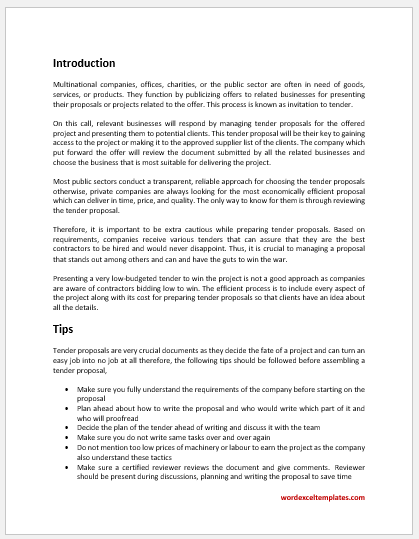A tender is another name for helping a business obtain a new business opportunity. Unlike bids, tenders are usually on the buyer’s side. Some people also consider a tender a proposal because they make an offer to buy some products or services from them.
What is a tender proposal?
A tender proposal is always written in response to a company’s request for proposal (RFP). In this proposal, the buyer generally expresses his interest in expanding his business by working with you.
Who writes the tender proposal?
Entrepreneurs interested in expanding their business usually draft a proposal to gain more clients and exposure to the market. Whether you are a small business owner or run a big enterprise, you might want to expand your business in years to come. You will be required to reach more clients to meet your goals of increasing your business. In some parts of the world, a tender proposal is a tool that advertises a business.
Writing a tender proposal:
When you are ready to write the first tender proposal of your life, you might be confused about how to draft the one that not only persuades the reader but also helps you succeed. You must know the ins and outs of the offer you make and the format to follow. To write a winning proposal, the following are some key points to be kept in mind:
Know your sector:
It is important to note that every proposal’s format and content vary from sector to sector. You should know in which industry you are running your business and from which segment of that society you belong to. When you are aware of the industry, you will be able to search for the tender in a better way. Tenders are marketed via newspapers and other media sources, and you will be required to end up finding that one tender that will be suitable for them.
Know your budget:
Before you start writing a winning proposal, knowing how much you can afford to invest is important. You should consider your business’s revenue stream and then determine how much you are ready to spend. You must let the recipient know how much you can spend on the particular tender.
Don’t rely only on estimates. Real figures might differ from estimates, and you will put yourself in hot water by committing to pay what you cannot. So, determine your affordability.
Give the overview of your company:
The tender proposal is always written to convince the reader, and this can be achieved if you don’t miss out on any important information. The most significant part of the tender proposal is the overview of the company targeting the particular tender. This will enable the recipient to decide whether you are relevant to the tender and whether your proposal should be approved.
Mention how you meet the client’s requirements:
In the next section, you should write a proper response to the request made by the client. The client might have asked all those people to put forward a tender proposal if they think they can meet that particular tender’s needs. So, you must provide details on how your business can meet the client’s needs and what potential benefits can be brought to the client’s business.
Don’t deviate from the format:
Most proposal writers follow a format. The format makes it easy for the client to understand and read the proposal. When the client receives multiple proposals, he compares them section by section. When there is a format, the comparison becomes easy, and if you have something good to offer, your proposal will stand out.
Add appendix section:
When you have attached supporting documents to the proposal, include them in the appendix section so that the reader can easily find them.

File: Word (.docx) 2007
Size 22 KB
- First Warning Letter for Negligence of Duty
- Ramadan Schedule Notification for Staff
- One Day Absent Note to Boss
- Request Letter to Staff for Voluntary Deduction from Salary
- Holiday Closing Messages
- Letter Requesting Transfer to another Department
- Letter Requesting Promotion Consideration
- Umrah Leave Request Letter to Boss
- Ramadan Office Schedule Announcement Letters/Emails
- Letter to Friend Expressing Support
- Letter to Employer Requesting Mental Health Accommodation
- Letter Requesting Reference Check Information
- Letter Requesting Salary Certificate
- Letter Requesting Recommendation from Previous Employer
- One Hour Off Permission Letter to HR